Fixed Route Shuttles Discount | Brightline
Offers
Get to and from the station with Brightline+
Getting there just got easier, for $10 for the first Guest and $5 for every additional rider in the same party.
Brightline+ Fixed Route Shuttles now offer pickup and dropoff service to and from Brightline MiamiCentral and Fort Lauderdale Stations. We also offer complimentary shuttles to and from Aventura Mall at Brightline Aventura Station.
Take a ride to or from the station to MIA International Airport or FLL International Airport. You can also hop on at one of our pickup locations, pay when you board, and get an affordable ride to the station.
Shuttles are available on a first come, first served walkup basis with a same-day Brightline train fare. Shuttles depart 10 minutes after train arrival and offer service to and from Brightline stations.
Book Now
MIA Airport Connector
Brightline MiamiCentral Station
East Exit (Past Joe & The Juice)
MIA Terminal D
Arrivals Level, Door 2
MIA Terminal E
Arrivals Level, Door 7
MIA Terminals G & F
Arrivals Level, Door 15
MIA Terminals H & J
Arrivals Level, Door 21
FLL Airport Connector
Brightline Fort Lauderdale Station
Terminal 1
Ground Transportation Zone B, Arrivals Level
Terminals 2 & 3
Ground Transportation Zone F, Arrivals Level
Terminal 4
Ground Transportation Zone B, Arrivals Level
Aventura Mall Shuttle
Brightline Aventura Station
Aventura Mall
Upper Level, Outside of Serafina Restaurant, Adjacent to Valet Parking
Monitor shuttle status and locations with live tracking
Location and Details
MiamiCentral Station
Address
161 NW 6 St,
Miami, FL 33136
Shuttle Service Hours Of Operation
MIA Airport Connector
Daily 6 AM – 11 PM
Station Shuttle Departures
10 minutes after every train arrival
Phone Number
831-539-2901
Location and Details
Aventura Station
Address
19796 West Dixie Highway,
Miami, FL 33180
Shuttle Service Hours Of Operation
Aventura Mall Connector
Everyday: 8AM – 8PM
Station Shuttle Departures
Every 30 mins
Phone Number
831-539-2901
Location and Details
Fort Lauderdale Station
Address
300 NW 2nd St,
Fort Lauderdale, FL 33311
Shuttle Servicep Hours Of Operation
FLL Airport Connector
Weekdays: 5 AM – 12 AM
Weekend: 7 AM – 1 AM
Station Shuttle Departures
10 minutes after the southbound train arrival
Phone Number
831-539-2901
ШОППИНГ-ШАТТЛ ПАРНДОРФ | BLAGUSS
These cookies are needed for a smooth operation of our website.
| Name | Purpose | Lifetime | Type | Provider |
|---|---|---|---|---|
| CookieConsent | Saves your consent to using cookies. |
1 year |
HTML |
Website |
With the help of these cookies we strive to improve our offer for our users. By means of providing video content or other useful content like maps to enhance the user experience.
| Name | Purpose | Lifetime | Type | Provider |
|---|---|---|---|---|
| GoogleMaps | Is used to connect to Google Maps and to display those maps. |
none |
Connection |
|
| AnachB | With AnachB you can look for public transport options to reach your destination with |
none |
Navigation |
anachb. |
| Palisis | With Palisis you can book shuttles and busses |
none |
Widget |
Palisis |
| Regiondo | With Regiondo you can book shuttles and busses |
none |
Widget |
Regiondo |
With the help of these cookies we strive to improve our offer for our users. By means of anonymized data of website users we can optimize the user flow.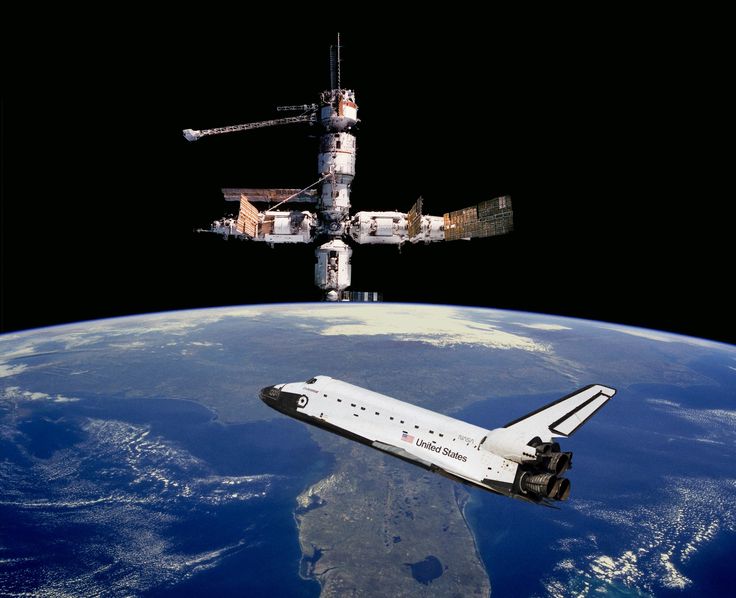
| Name | Purpose | Lifetime | Type | Provider |
|---|---|---|---|---|
| _fbp | Stores the unique visitor ID. |
28 days |
HTML |
|
| facebookPixel |
If JavaScript is not enabled, this pixel initiates a connection to facebook.
|
none |
Pixel |
|
| HubSpotNewsletter | A newsletter created via HubSpot is displayed on the Blaguss page. |
none |
Widget |
HubSpot |
Dies sind nicht unbedingt notwendige Cookies, die vom Cookie-Banner gesteuert werden. Wenn Sie ein Besucher auf einer von HubSpot unterstützten Website sind, können Sie sich von diesen Cookies abmelden, indem Sie keine Einwilligung erteilen.
| Name | Purpose | Lifetime | Type | Provider |
|---|---|---|---|---|
| __hstc |
Das Haupt-Cookie für das Besucher-Tracking.
|
13 months |
Tracking |
HubSpot |
| hubspotutk | Dieses Cookie verfolgt die Identität eines Besuchers. Dieses Cookie wird bei der Einsendung eines Formulars an die HubSpot-Software übergeben und beim De-duplizieren von Kontakten verwendet. |
13 months |
Tracking |
HubSpot |
| __hssc | Dieses Cookie verfolgt Sitzungen. |
30 minutes |
Tracking |
HubSpot |
| __hssrc |
Immer dann, wenn die HubSpot-Software das Sitzungscookie ändert, wird auch dieses Cookie gesetzt. Damit wird bestimmt, ob der Besucher den Browser erneut gestartet hat. Damit wird bestimmt, ob der Besucher den Browser erneut gestartet hat.
|
30 minutes |
Tracking |
HubSpot |
Sunset of the shuttle era | Science and life
An entire era in the history of world cosmonautics is coming to an end. The account goes on for months. America’s reusable spacecraft, known as the “Space Shuttle”, or space shuttles, will soon go to museums. What will replace it, we don’t know yet. But the remaining shuttles will have time to make one more flight. And these flights will obviously go down in history as the final phase of many years of very fruitful work in near space.
The Atlantis spacecraft is approaching the Mir station (NASA illustration).
Launch (STS-66) of spacecraft Atlantis (photo by NASA).
Space Shuttle layout diagram.
US Space Shuttle compared to Russian Soyuz (NASA illustration).
STS-132 mission crew: Kenneth Ham in front, Michael Good, Garret Reisman, Anthony Antonelli, Steven Bowen, Pierce Sellers (NASA photo) in the back from left to right.
The winning design for the 30th Anniversary logo competition.
Canadian Dextre robotic arm (NASA photo).
Russian science module MIM-1 (photo by RSC Energia).
‹
›
View full size
Cruise ships
altitude and speed levels. It seemed logical: at 19In the 30s, the groundwork for aviation technology was already great, and the only problem was the creation of a workable engine. However, the massive use of German V-2 (A-4) heavy ballistic missiles during the war radically changed pre-war ideas. In the Soviet Union, the study of the German experience led to the fact that a line of rockets was built (R-1, R-2, R-5) and the “magnificent seven” (R-7) was designed – a launch vehicle that made it possible to launch the first an artificial satellite of the Earth and the ship “Vostok” with Yuri Gagarin on board, securing the priority of the Soviet Union in the development of near-Earth space.
In order to catch up and overtake the USSR, the Americans were also forced to adopt the German experience. As a result, the Jupiter and Saturn rockets appeared, created under the leadership of Wernher von Braun. However, work did not stop as part of an alternative program to create rocket planes that would be launched into space with the help of rockets, but would return to Earth in an airplane way. The goal of the program was to design the X-20 Dyna-Soar combat spaceplane, but the matter was limited to two hundred manned flights of X-15 rocket planes, which, although they managed to overcome the conditional mark of 100 km (this height legally separates the atmosphere from outer space), never got out of orbit.
NASA designers returned to the aerospace concept at the beginning of 1972, when the lunar program was approaching the final. Ambitious plans to conquer other planets had to be postponed – the Americans simply did not have enough funds to continue active space expansion.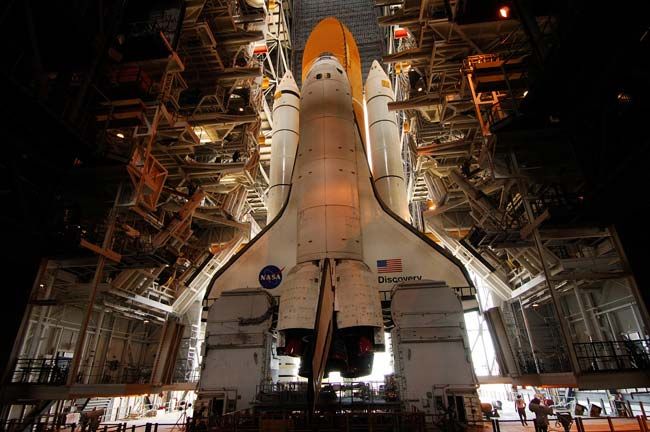
From the very beginning, shuttles were conceived as winged manned spacecraft. A ship was created on which any healthy person could go into space, and not just a specially trained astronaut. At the same time, it was expected that the operation of the new ship would significantly reduce the unit cost of the payload launched into orbit. Economic calculations confirmed that under certain conditions (thirty flights a year, the complete rejection of disposable carriers, the launch of commercial satellites and research vehicles), it would be possible to fully recoup the costs.
The American military also put forward their demands. A useful mass of 29.5 tons was supposed to be put into orbit with a mass of 14.5 tons of cargo returned to Earth; the possibility of lateral maneuver was envisaged during descent in the atmosphere (up to 2000-2500 km).
By March 1972, the shape of the shuttle that is known today was approved: starting solid-fuel boosters, a fuel tank and an orbital ship with three sustainer engines. The development of such a system, which reuses everything except the external tank, was estimated at $5.15 billion.
On July 26, 1972, North American Rockwell’s Space Transportation Systems Division awarded a $2.6 billion contract to the US government to design the spacecraft, produce two bench models and two flight models. The contract for the creation of sustainer engines was received by Rocketdyne, the external fuel tank – Martin Marietta, launch boosters – United Space Boosters Inc.
Initially, the ships were assigned the designations OV-101, OV-102, and so on. The construction of the first ship OV-101 was completed on September 17, 1976, and it was named “Enterprise” (Enterprise) in honor of the legendary starship from the science fiction television series “Star Trek”. After flight tests in the atmosphere, it was supposed to be converted into a space version, but OV-102 was still supposed to be the first to go into orbit.
During the tests of the Enterprise, which took place at 1977 and 1978, it turned out that the wings and fuselage needed to be significantly strengthened, and this required a complete disassembly of the ship.
On January 25, 1979, NASA announced the names of four orbital spacecraft: OV-102 became Columbia, OV-099 became Challenger, OV-103 became Discovery, and OV-104 became “Atlantis” (Atlantis). Previously, these names belonged to the United States Marine Research Vessels.
Triumphs and tragedies
Preparation for the flight of STS-1 (all shuttle missions were abbreviated as STS, that is, Space Transport System – space transport system, and the number indicated the serial number of the flight) of the Columbia shuttle began in November 1980. The path of the new ship to the stars was overshadowed by tragedy. On March 19, 1981, when the tail section of the ship was filled with nitrogen, six workers who were in it were severely poisoned and two of them died.
The first start of “Columbia” came on April 12, 1981 – exactly 20 years after the flight of Yuri Gagarin! Subsequently, it was claimed that this was done on purpose, but in fact the launch was planned for April 10 and was postponed due to a serious failure of computer systems.
The spacecraft was piloted by astronauts John Young and Robert Crippen. Problems began immediately after the launch of the ship into orbit – it turned out to be too low to continue the flight: 148 km at apogee and only 24 km at perigee. The astronauts had to carry out re-extraction by turning on the engines twice. If the engines had not worked, the flight could have ended in disaster on the first orbit. In addition, after returning to Earth, engineers discovered noticeable damage to the ship’s thermal protection. Nevertheless, the test flight was considered a success.
For thirty years, shuttles have become the main vehicle of the US space agency (NASA). Let us list some stages of a new era in space exploration.
In June 1983, the crew of the Challenger spacecraft (STS-7 mission) included the first American, Sally Ride, who became the third woman to orbit, after Valentina Tereshkova and Svetlana Savitskaya. Since then, American women have been flying regularly on shuttles, and in July 1999, Eileen Collins even acted as the crew commander of the Columbia (STS-93).
In November 1983, the Columbia spacecraft (STS-9) entered orbit for the first time with the Spacelab research laboratory, developed by Europeans commissioned by NASA. This module included a sealed compartment for experiments in weightlessness and an open platform for studying near-Earth space. The laboratory has been used repeatedly, allowing hundreds of experiments to be carried out in the interests of the fundamental sciences.
In April 1990, the Discovery spacecraft (STS-31) delivered the Hubble Space Telescope into orbit, with the help of which many amazing discoveries were made in the field of the structure and history of the Universe. In addition, the telescope has become a testing ground for testing the procedure for multiple repairs in orbit. Four expeditions were carried out on the shuttles to service the telescope, which made it possible to significantly extend its service life. The last one, on the ship Atlantis, took place in May 2009of the year.
In the 1990s, the shuttles took part in the Russian-American Mir-NASA program.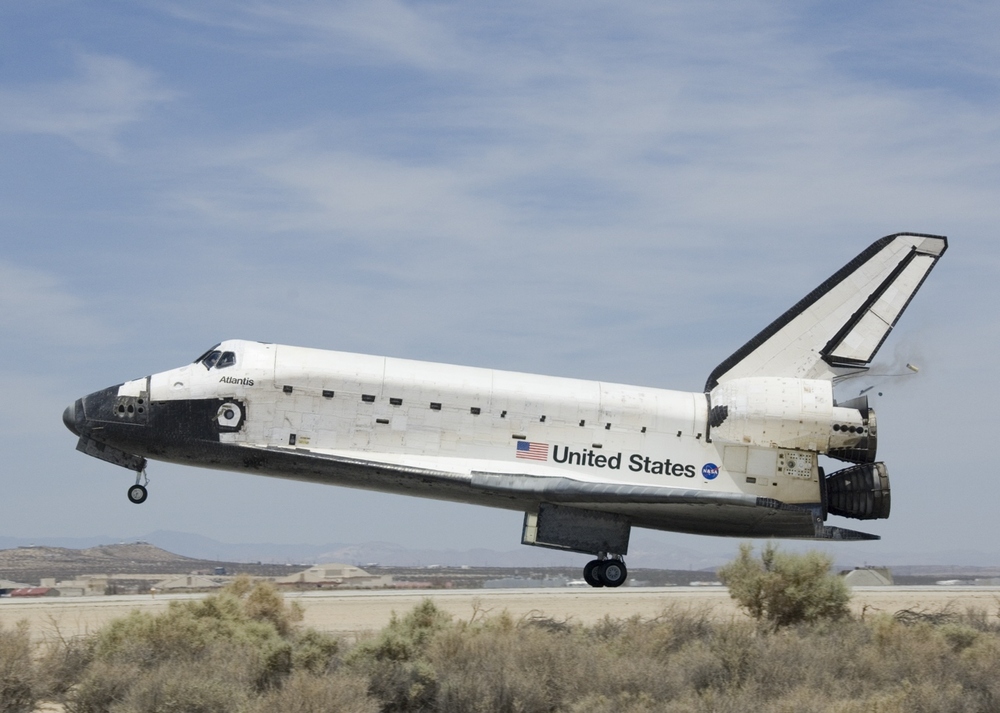
But not all shuttle expeditions were successful. Although during the operation the ships were repeatedly modified, however, in the most constructive scheme of this space system, “delayed mines” were laid. The first of them “rushed” on January 28, 1986. On that day, the Challenger spacecraft set off on its tenth flight (STS-51 L). It was supposed to deliver a relay satellite and an apparatus for observing Halley’s comet into space. Another feature of the mission was that for the first time a non-professional astronaut went into orbit as part of the crew – 37-year-old teacher Christa McAuliffe, who won the presidential competition.
The crew could have been saved if the shuttle cabin had been equipped with an emergency rescue system, and such a system was developed during the preliminary design stage. However, it made the ship much heavier, and the designers eventually abandoned it, relying on the high reliability of the space shuttles.
The catastrophe and the death of the astronauts shocked America. In those days, the correctness of NASA’s strategic choice was called into question: it turned out that reusable aerospace vehicles were less reliable than purely ballistic disposable ones. Then the US leadership was not yet ready to revise the national space program. Instead of the Challenger, a new OV-105 shuttle, the Endeavor, was built.
But the ruthless cosmos struck again. On February 1, 2003, while returning to Earth, the Columbia ship was destroyed due to the fact that the thermal protection on the left wing was damaged. All crew members died, including Israel’s first astronaut, Ilan Ramon.
Thermal protection tiles fell off the skin of the shuttles before, they even stopped paying attention to this, which ultimately led to a terrible disaster.
After that, the fate of the shuttles was a foregone conclusion. On January 14, 2004, US President George W. Bush spoke at NASA Headquarters in Washington. In his speech, he announced the New Horizons program, which includes a complete overhaul of strategy in favor of capsule-type spacecraft. Aerospace systems have been discredited, and all large-scale projects for their further development, including the Russian Clipper spacecraft, have been mothballed indefinitely.
By March 2010, the shuttles had made 130 flights, of which: Discovery – 37, Atlantis – 31, Columbia – 28, Endeavor – 24, Challenger – 10.
Last flight of Atlantis
On May 14, 2010, shuttle Atlantis will depart for its last flight (STS-132). This will be the 34th launch to the International Space Station.
The ship will be operated by a crew of six astronauts. Kenneth Ham is appointed commander of Atlantis, Anthony Antonelli is the pilot, flight specialists are Steven Bowen, Karen Nyberg, Garret Reisman and Piers Sellers. Kenneth Ham and Karen Nyberg made a space flight in May 2008 on the Discovery (STS-124), on it in March 2009flew by Anthony Antonelli (STS-119). Stephen Bowen went into space in November 2008 on the Space Shuttle Endeavor (STS-126). Garret Reisman was a member of Expedition 16 of the ISS. And Piers Sellers is flying for the third time – before that he was a member of the Atlantis (STS-112) and Discovery (STS-121) missions.
The expedition will have to complete the construction of the ISS. Spare parts for the Canadian Dextre robot-manipulator, a spare radiator, an airlock and a European ERA (European Robotic Arm) for the Russian multi-purpose laboratory will be delivered there.
However, the main cargo of the shuttle this time will be the Russian scientific module MIM-1 (Dawn), which is planned to be docked to the lower port of the Russian module Zarya.
MIM-1 was created by specialists of the Energia Rocket and Space Corporation. The launch weight of the module is 7.9 tons, the volume for cargo and scientific equipment is 5 m 3 .
MIM-1 and previously delivered MIM-2 are the first dedicated research modules in the Russian segment (PC) of the station. Until now, our cosmonauts have carried out experiments either in the service compartment or in the functional cargo block, which literally made life difficult for them.
There are five universal workplaces in the pressurized compartment of MIM-1. All of them will be in demand during the implementation of the long-term program of scientific and applied research and experiments planned for the ISS RS. So far, the necessary equipment has not been installed in MIM-1, so the program will start only after the delivery of the relevant instruments on Progress cargo ships.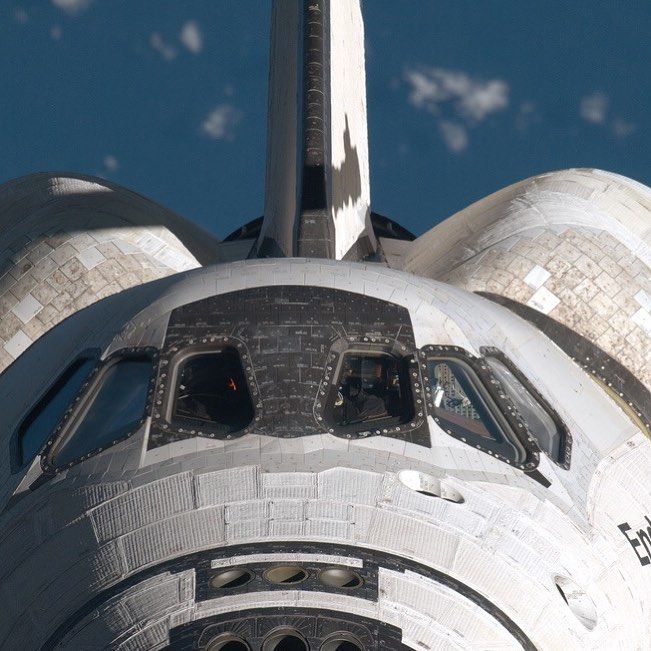
Vitaly Lopota, President and General Designer of RSC Energia, spoke a little about the nature of future research: “In biotechnology, these are all kinds of growth technologies, including stem cells, and in materials science, research in near-critical states of heat and mass transfer in liquids, in polymers. In fact, this is research and the creation of new materials in outer space and microgravity.”
After docking with the ISS, the module will be removed from the shuttle’s cargo compartment and docked to Zarya using the station’s manipulator.
The entire operation will take four to six hours. It will take about two more months to check all systems and “revive” the module. This will require several spacewalks. A radiator and another lock chamber will be installed outside the module for docking the next research module, which is scheduled to launch in 2012.
On December 14, 2009, the packed MIM-1 was taken along the railway line to the Ramenskoye airport near Moscow.
Astronautics at a crossroads
Atlantis astronauts will take with them a laser disc containing dozens of sketches of the emblem created by NASA employees as part of a competition established to mark the 30th anniversary of the shuttle era – which, as you might guess, will coincide with the celebration 50th anniversary of Yuri Gagarin’s flight. This symbolic gesture is filled with deep sadness, because so far no one can say what awaits the American astronautics.
Until recently, active work was underway under the Constellation program, which provided for the creation of new Ares I (Ares) and Ares V launch vehicles, designed on the basis of technologies used in shuttles, and new Orion spacecraft (Orion), which could reach not only Earth orbits, but also the Moon. However, the program is currently curtailed by the decision of President Barack Obama.
After closing Constellation, Barack Obama called for more active involvement of private business in space affairs. Indeed, there are already two companies that do not hide their ambitious plans for space exploration. SpaceX and Orbital, under contract with NASA, are developing rockets and cargo spacecraft designed to supply the ISS. Thus, SpaceX creates the Falkon 9 launch vehicle and the Dragon spacecraft, while Orbital creates the Taurus II launch vehicle and the Cygnus spacecraft. Tentatively, the ships will go into orbit as early as 2011. But experts quite reasonably point out that it is short-sighted to rely on “private traders” in such an important issue, because the latter have underestimated flight safety criteria.
The future of space exploration is uncertain. Only one thing can be said for certain: after the shuttles are laid up forever, the main burden of continuing the work of mankind in near-Earth orbit will fall on the shoulders of Russian scientists and cosmonauts.
Shuttle | it’s… What’s a shuttle?
Space shuttle on the launch pad.
Cape Canaveral, Florida, USA
Shuttle Atlantis lands
NASA tracked transporter transports space shuttle
Space transport system (eng. Space Transportation System ), better known as Space Shuttle The shuttle is launched into space using launch vehicles, maneuvers in orbit like a spacecraft, and returns to Earth like an airplane. It was understood that the shuttles would scurry like shuttles between Earth orbit and the Earth, delivering payloads in both directions. During the development, it was envisaged that each of the shuttles had to launch into space up to 100 times. In practice, they are used much less. To date (April 2009) the most flights – 36 – were made by the Discovery shuttle.
Contents
|
Application History
The shuttle program has been developed by North American Rockwell on behalf of NASA since 1971.
The Columbia shuttle was the first operational reusable orbiter. It was made in 1979 and transferred to NASA’s Kennedy Space Center. The shuttle “Columbia” was named after the sailing ship on which Captain Robert Gray in May 1792 years explored the inland waters of British Columbia (now the US states of Washington and Oregon). Columbia is designated by NASA as OV-102 (Orbiter Vehicle – 102). The space shuttle Columbia was lost on February 1, 2003 (flight STS-107) while entering the Earth’s atmosphere before landing.
The second Space Shuttle Challenger was handed over to NASA in July 1982. It was named after a seagoing vessel that explored the ocean in the 1870s. The NASA designation for the Challenger is OV-09.9. The Challenger died on its tenth launch on January 28, 1986.
The third shuttle, Discovery, was handed over to NASA in November 1982.
The shuttle Discovery was named after one of two ships that, in the 1770s, British Captain James Cook (eng. James Cook ) discovered the Hawaiian Islands and explored the coast of Alaska and northwestern Canada. The same name (“Discovery”) bore one of the ships of Henry Hudson, who explored Hudson Bay in 1610-1611. Two more Discoveries were built by the British Royal Geographical Society to explore the North Pole and Antarctica in 1875 and 1901 years. At NASA, Discovery is designated OV-103.
The fourth shuttle, Atlantis, entered service in April 1985.
The fifth shuttle, Endeavor, was built to replace the lost Challenger and entered service in May 1991.
Before the Columbia, another shuttle was built – the Enterprise, which in the late 1970s was used only as a test vehicle for practicing landing methods and did not fly into space. At the very beginning, it was supposed to name this orbiter “Constitution” (Constitution) in honor of the bicentenary of the American Constitution. Later, following numerous suggestions from viewers of the popular television series Star Trek, the name “Enterprise” was chosen. NASA designates the Enterprise as OV-101.
Construction
Space Shuttle Orbiter.
The shuttle consists of three main components: Orbiter (Orbiter), which is launched into low Earth orbit and which is, in fact, a spacecraft; large external fuel tank for main engines; and two solid rocket boosters that operate within two minutes of launch.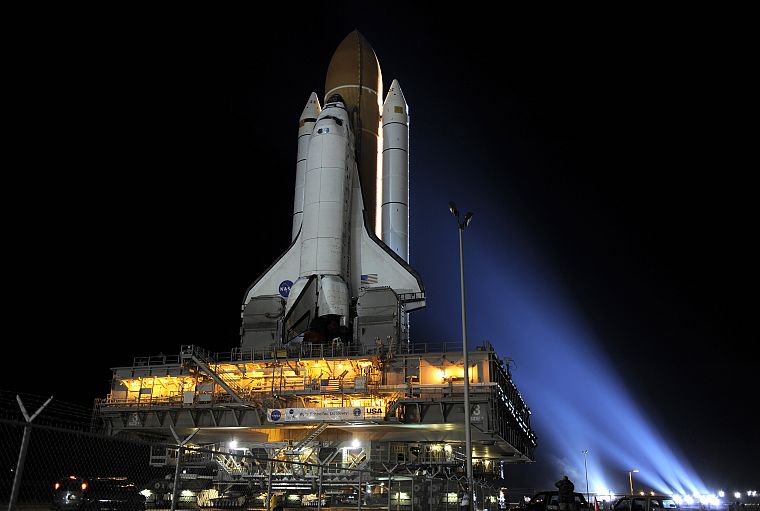
Flight duration
Docking of shuttle Atlantis and orbital station Mir.
The shuttle is designed for a two-week stay in orbit. The longest space travel was made by the shuttle Columbia in November 1996 (flight STS-80) – 17 days 15 hours 53 minutes. The shortest space trip was made by the shuttle Columbia in November 1981 (flight STS-2) – 2 days 6 hours 13 minutes. Usually shuttle flights last from 5 to 16 days.
Crew
The smallest shuttle crew consists of two astronauts – the commander and the pilot. The largest shuttle crew is eight astronauts. Typically, the crew includes five to seven astronauts. There were no unmanned launches.
Orbits
Shuttle orbits range from approximately 185 kilometers (115 miles) to 643 kilometers (400 miles).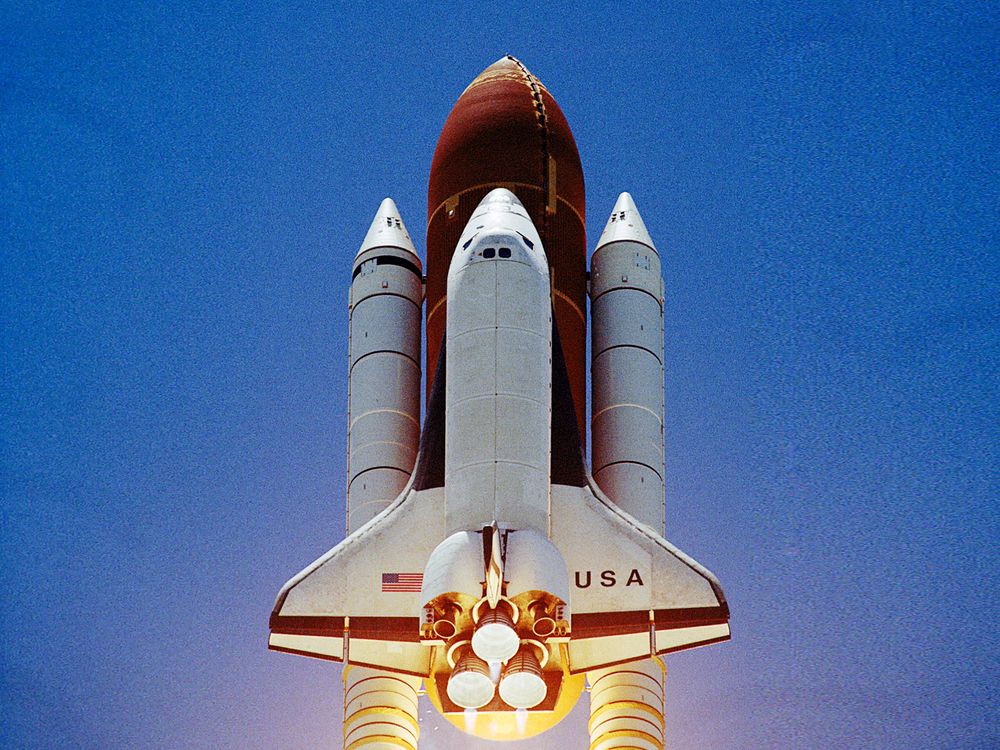
Payload
The space-delivered payload of the orbital stage (orbital aircraft) for low Earth orbit is 24.4 tons. The maximum weight of a loaded spacecraft in orbit is 120-130 tons. From 19For 81 years, more than 1,360 tons of payloads have been delivered into orbit with the help of shuttles.
In total, as of April 2009, the shuttles made 125 flights, of which: Discovery – 36, Atlantis – 29, Columbia – 28, Endeavor – 22, Challenger – 10.
Tasks
Space shuttles are designed to launch cargo into orbits with a height of 200-500 km, conduct scientific research, service orbital spacecraft (assembly and repair work).
The Space Shuttle Discovery delivered the Hubble telescope into orbit in April 1990 (flight STS-31). On the shuttles Columbia, Discovery, Endeavor and Atlantis, four expeditions were carried out to service the Hubble telescope. The last shuttle mission to Hubble took place in May 2009. Since NASA had planned to stop shuttle flights since 2010, this was the last human expedition to the telescope, because these missions cannot be performed by any other available spacecraft.
Endeavor shuttle with open cargo hold.
In the 1990s, the shuttles took part in the joint Russian-American program – the Space Shuttle – Mir. Nine dockings were made with the Mir station.
During the twenty years that the shuttles have been in service, they have been constantly developed and modified. Over a thousand major and minor modifications were made to the original shuttle design.
Shuttles play a very important role in the implementation of the project to build the International Space Station (ISS).
Three shuttles, Discovery, Atlantis and Endeavor, remain in service after the Columbia disaster. These remaining shuttles should ensure the completion of the ISS until 2010. NASA announced the end of shuttle operations in 2010.
The Space Shuttle program, as well as the Energiya-Buran reciprocal program, were originally designed for military use as well. Both space shuttles have design capabilities for nuclear bombardment from Earth orbit.
Technical data
Dimensions of the Space Shuttle
Dimensions of the Space Shuttle compared to the Soyuz
| Height at the starting position | 56.14 m |
| Starting weight | 2045 t |
| Payload weight | 29.5 t |
| Payload percentage of total weight | 1.4% |
| Launch lift | 30,806 kN (3141 tf) |
Solid fuel booster
-
Main article : Side booster MTKK Space shuttle
| Length | 50 m |
| Diameter | 3.71 m |
| Total weight of two accelerators | 1180 t |
| Two Booster Lift | 25,500 kN (2600 tf) |
| Specific impulse | 269 with |
| Operating hours | 123 with |
External fuel tank
The tank contains fuel and oxidizer for the three “ SSME ” (or “ RS-24 “) liquid engines in the orbiter and does not have its own engines.
| Length | 47 m |
| Diameter | 8.38 m |
| Starting weight | 756 t |
| Thrust at sea level (104.5%) | 5252 kN (535.5 tf) |
| Specific impulse | 455 with |
| Operating hours | 480 with |
| Fuel | liquid hydrogen |
| Mass of fuel at start | 103 t |
| Oxidizer | liquid oxygen |
| Mass of oxidizer at launch | 616 t |
Orbiter
In addition to the three main engines of the orbiter, two engines of the orbital maneuvering system (“ OMS “), each with a thrust of 27 kN, are sometimes used at the start. The fuel and oxidizer of System OMS is stored on the shuttle, used in orbit and for return to Earth.
| Length | 37.24 m |
| Wingspan | 23. 79 m 79 m |
| Weight (without payload) | 80 t |
| Total lift at launch | 5306 kN (541 tf) |
| Specific impulse | 316 with [1] |
| Operating hours | 1250 s [2] |
| Fuel | methylhydrazine (MMH) [1] |
| Oxidizer | dinitrogen tetroxide (N 2 O 4 ) [1] |
List of shuttle flights
Each manned flight under the Space Shuttle program has its own designation, which consists of the abbreviation STS (eng. Space Transportation System – space transport system) and the serial number of the shuttle flight. For example, STS-4 means the fourth flight of the Space Shuttle program. Serial numbers were assigned at the planning stage for each flight. But in the course of preparation, many flights were postponed or postponed to other dates.
Since 1984 a new designation system has been introduced. The abbreviation STS remained, but the serial number was replaced by a code combination, which consisted of two numbers and one letter. The first digit in this codeword corresponded to the last digit of the current year, not the calendar year, but NASA’s fiscal year, which ran from October to October. For example, if the flight takes place in 1984 until October, then the number 4 is taken, if in October and later – the number 5. The second digit in the code combination was always 1. The designation 1 was adopted for shuttle launches from Cape Canaveral. Previously, the shuttles were also scheduled to launch from Vandenberg Air Force Base in California; the number 2 was planned for these launches.
Example: flight STS-51A – took place in November 1984 (number 5), this was the first flight in the new budget year (letter A), the shuttle started from Cape Canaveral (number 1).
After the Challenger disaster in January 1986, NASA reverted to the old designation system.
Cost
In 2006, the total cost was $160 billion, by which time 115 launches had been completed (see Space Shuttle Cost ). The average cost per flight was $1.3 billion, but the bulk of the cost (design, upgrades, etc.) does not depend on the number of launches – so other estimates put the cost of each flight at $600 million.
The cost of launching a cargo analogue – Proton-M with a payload of 22 tons is $ 25 million.

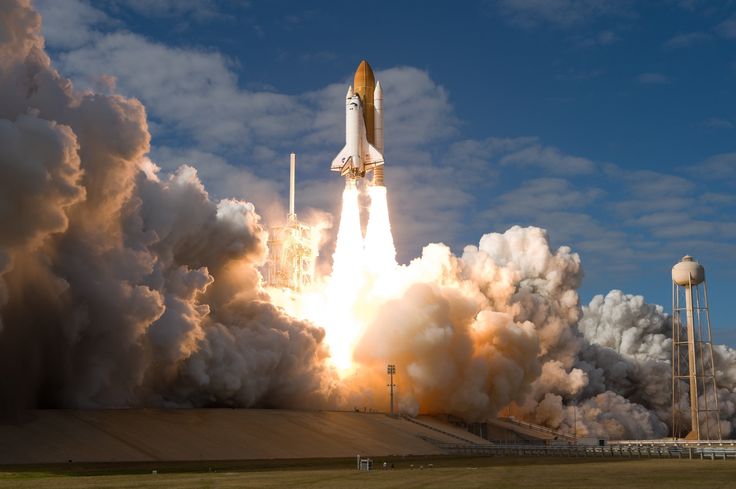 vor.at
vor.at 2 Crew
2 Crew 